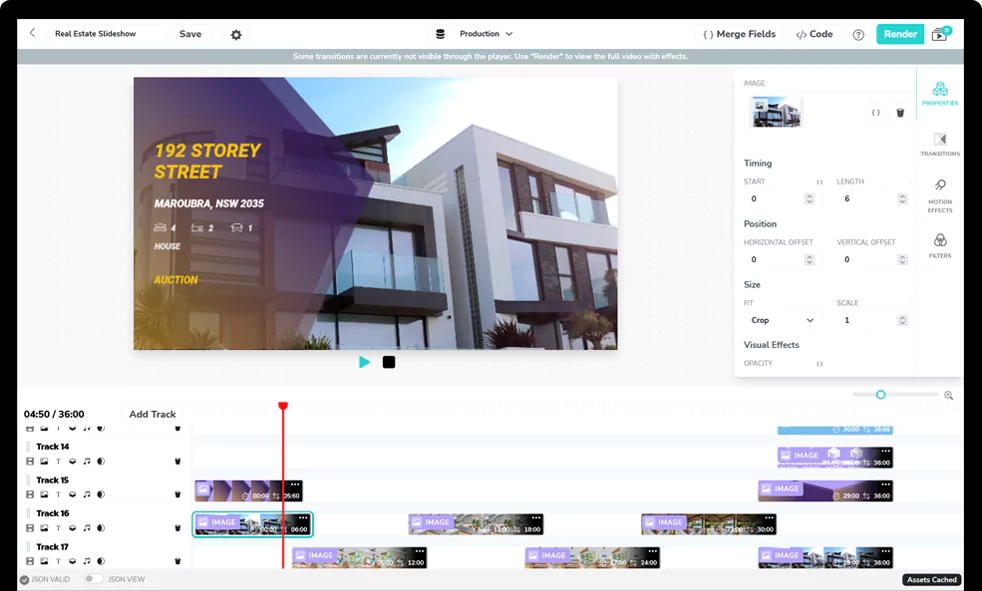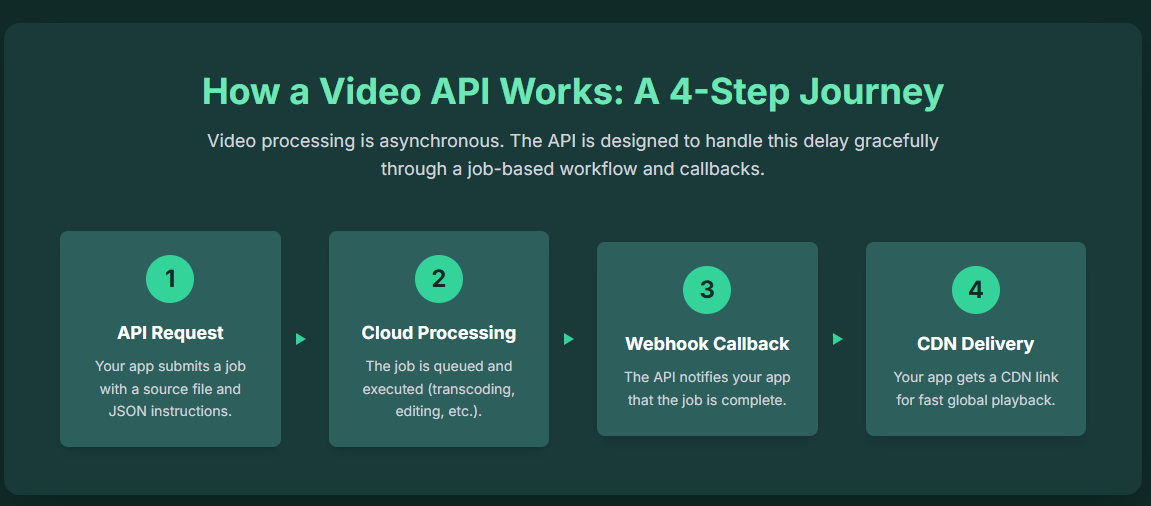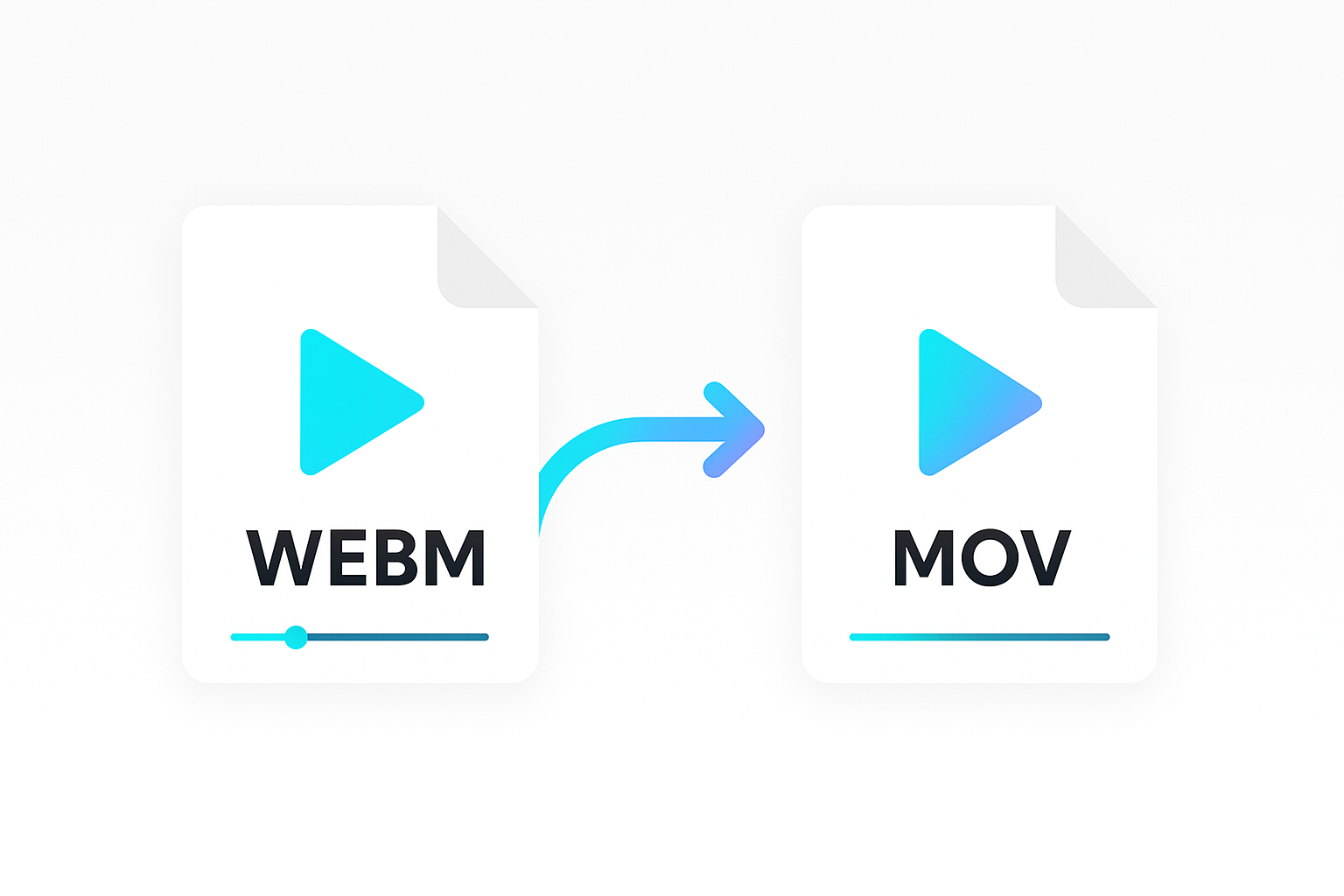What is a video API?
TL;DR:
A video API is a programmable control layer that lets developers add powerful video features to applications without building the complex backend infrastructure themselves. This service enables you to handle everything, from video processing and editing to global delivery, through simple code-based commands.
This guide covers:
- Why you need a video API: The “build vs. buy” video infrastructure tradeoff.
- How video APIs work: A high-level look at the architecture.
- The different types: A breakdown of APIs for processing, editing, AI generation, and so on.
- How to choose and implement the right one for your use case: Evaluating features, cost, and technical requirements.
The challenge of video at scale
Video content dominates the internet. According to Sandvine’s 2024 Global Internet Phenomena report, video is the largest application category on the internet, responsible for about 38% of global downstream traffic. But behind every simple “play” button is a world of technical complexity.
Building reliable video infrastructure from scratch can be a monumental task. Developers have to contend with several challenges:
- Transcoding & codecs: Converting a single uploaded file into dozens of formats (MP4, WebM), codecs (H.264, AV1), and resolutions to work on every device.
- Adaptive bitrate streaming: Creating multiple quality levels and a manifest file so that playback is smooth on both high-speed fiber and spotty mobile connections.
- Global delivery: Leveraging a Content Delivery Network (CDN) to ensure fast load times for users in Sydney, Stockholm, and San Francisco.
- Scalability & storage: Managing the infrastructure to handle a thousand simultaneous streams and petabytes of data.
For most teams, building this is a costly, time-consuming distraction from their core product. This is the problem that video APIs are designed to solve. They package this entire complex infrastructure into a programmable service, allowing developers to execute complex video workflows with simple API calls.
Instead of building a complex video pipeline, you can focus on your application’s user experience, treating video infrastructure as a utility you can simply plug into.
Do you need a video API? The build vs. buy decision
The reality is, most teams don’t stick with fully custom video stacks for long. Industry data by Bitmovin indicates a steady shift toward commercial services across encoding, DRM, CDNs, and players. In contrast, in-house player builds are declining due to rising costs and increasing complexity.
When building your own makes sense:
- Video infrastructure IS your competitive advantage (Netflix, TikTok, YouTube, etc.)
- You’re processing millions of videos monthly, where economies of scale kick in.
- You have specific requirements that no API provider meets.
- You have a team of dedicated engineers with a deep understanding of video protocols.
When a video API wins:
- Video enhances your product, but it isn’t the core value proposition.
- You need production-ready video features in days, not quarters.
- Your volume is less than 1,000,000 videos monthly.
- You want predictable operational expenditure (OpEx) instead of capital expenditure (CapEx) surprises.
The decision ultimately comes down to focus. Every hour your team spends debugging FFmpeg parameters or optimizing CDN caching rules is an hour not spent on your actual product differentiation.
How video APIs work: A high-level overview
While different video APIs serve different functions, most share a common architectural pattern built around asynchronous processing. Unlike a simple web request where you get an immediate answer, video processing takes time—from a few seconds for a short clip to hours for a full-length movie.
Here’s a high-level breakdown of the typical asynchronous request and processing flow:
1. The API request: Submitting the job
Your app sends a request to the API with:
- Source media: a cloud URL or a direct upload.
- Instructions: a simple JSON payload describing what to do (for example, a template with edits, transcodes, watermarks, and thumbnails).
- Optional webhook URL: where to notify you when it’s done.
- Authentication key: to identify your account and authorize the request.
The API responds quickly with a job ID you can use to check status. Every API works differently. This is an asynchronous request, but an API request can be synchronous as well, depending on the speed and complexity of the task you’re asking it to perform.
2. The processing pipeline
The platform providing the API handles the pipeline:
- Ingest: securely fetches your file.
- Queue: places work in a queue so it can scale to thousands of concurrent jobs.
- Execute: runs the tasks (transcoding for multiple devices, generating thumbnails, extracting audio, AI transcription, or stitching clips) without you managing servers or codecs.
3. The webhook callback
Because you can’t just wait for the request to complete, the API needs a way to tell your application when the job is finished. This is done using a webhook.
- When you submit the initial job, you also provide a URL to an endpoint in your own application.
- Once the video processing is complete, the API sends a notification (a POST request with a JSON payload) to your webhook URL. This payload contains the status of the job and, most importantly, the URLs for the finished video files and other assets.
4. The final delivery
You receive URLs to the finished assets — often time-limited, signed links — or the service writes directly to your bucket. Most teams serve video through a CDN, so users are routed to a nearby edge location for faster starts and fewer stalls.
Different types of video APIs
The term “video API” is a broad category, and different APIs are designed to solve very different problems. Understanding these distinctions is the key to finding the right tool for your specific use case. Most solutions can be grouped into one of these main categories.
Video editing APIs
These APIs let you programmatically create and modify videos through code — essentially automated video editing at scale. You send instructions in JSON format describing what you want (merge these clips, add this text overlay, apply this transition), and the API handles the rendering.
We’re talking about generating thousands of personalized marketing videos, automatically creating social media clips from longer content, or building dynamic product demonstrations that update with your inventory.
The Shotstack video editing API, for example, uses a timeline-based JSON structure. You define a template once, then generate unlimited variants by changing the data payload.
Use cases
- Marketing automation platforms
- Social media management tools
- E-learning systems
- Real estate platforms
- News organizations
👉 More on this in the video editing API guide.
Video streaming APIs
These APIs are for hosting, managing, and delivering existing video content. You upload a finished video file, and the API handles all the complex background work (transcoding, storage, and global delivery) to ensure a high-quality playback experience for your viewers.
Think of this as building your own YouTube or Netflix-style functionality. The API gives you a simple, embeddable player or a URL that works perfectly on any device, anywhere in the world, without you ever having to manage a server or a CDN.
Use cases
- Online learning platforms
- Corporate training systems
- Media and entertainment sites
- Live commerce applications
- Applications with user-generated content (UGC)
AI video generation APIs
A fast-growing category, these APIs generate videos from text prompts, create AI avatars, or transform existing content using machine learning. You send a text script, and the API returns a video with an AI presenter. Or feed it a product image, get back a rotating 360° video.
Shotstack’s AI video generator API integrates several AI models for features like image-to-video, text-to-image, and text-to-speech with lip-sync AI avatars.
Use cases
- Training content at scale
- Personalized marketing messages
- Multilingual content localization
- Prototyping new concepts
- News videos with AI avatars
Live streaming APIs
These APIs provide the infrastructure for broadcasting video in real-time from one source to many viewers. You send a live feed from a camera or streaming software (like OBS), and the API distributes it globally with low latency.
This is the technology behind live events. It allows you to host webinars, broadcast sports, or run virtual conferences. Many of these APIs also include features to record the live stream, making it instantly available for on-demand replay after the event ends.
The technical complexity here is substantial, managing RTMP/WebRTC ingestion, real-time transcoding, and ultra-low latency delivery.
Use cases
- Live shopping platforms
- Virtual events and webinars
- Sports streaming
- Gaming and esports broadcasting
Video communication APIs
These APIs enable real-time, two-way (or multi-way) video calls between users directly within your application. They provide the backend infrastructure needed to build interactive, conversational video experiences without relying on third-party software.
Instead of sending users to Zoom or Google Meet, you can build that functionality right into your platform. The API handles the complex peer-to-peer connections and server relays required for stable, low-latency conversations.
Use cases
- Telehealth platforms
- Online tutoring and education
- Customer support with video
- Remote collaboration tools
- Virtual event networking calls
👉 The boundaries between these categories are blurring. Modern video APIs increasingly offer multiple capabilities combined into one API. A streaming API might add live features, or an editing API might incorporate AI generation. Choose based on your primary use case, but also look for providers that can grow with your needs.
Technical implementation considerations for developers
Once you’ve identified the right type of API for your project, the next step is implementation. While every API has its own specific architecture, most professional-grade video services share a common set of technical patterns that developers need to understand.
Authentication
First, you need a secure way to communicate with the API. Authentication patterns differ between providers, but they generally fall into two categories.
For server-to-server communication, the most common method is a single, secret API key. You include this key in the header of your request (e.g., x-api-key: your_secret_key), and the API uses it to identify and authorize your application.
For workflows that involve a client-side component (like a direct browser upload), a public/secret key pair is often used. The public key can be safely exposed in the browser to identify your account, while the secret key remains on your server to sign and authorize sensitive requests. In either case, your secret keys must be protected and never exposed in client-side code.
Asynchronous processing & webhooks
Video processing is not instantaneous. You can’t just send a request and wait for the video to be ready. Even when an API offers a synchronous endpoint, the heavy lifting on the backend is typically still handled asynchronously to allow for scale and reliability. A solid understanding of asynchronous workflows is therefore critical.
The standard pattern is to use webhooks. When you submit a job to the API, you also provide a URL to an endpoint in your own application. The API will do its work in the background and, once complete, will send a notification (a POST request with a JSON payload) to your webhook URL.
Your application must be set up to listen for this callback, parse the response, and then take the next action, such as updating a database record with the URL of the finished video.
Error handling
Things can go wrong in a distributed system. A source video might be corrupted, a network connection could fail, or your own webhook endpoint might be temporarily down. A robust implementation requires solid error handling.
Rate limiting
To ensure stability for all users, API providers enforce rate limits — the number of requests you can make in a given period. It’s important to understand your chosen provider’s limits and build your application to respect them. This often involves implementing a queueing system on your end or using an exponential backoff strategy to handle rate-limiting errors gracefully.
Security & compliance
When handling user data or sensitive content, security is paramount. Look for APIs that offer security features like encryption for data both in transit (using TLS) and at rest.
Depending on your industry and region, you may have specific compliance requirements. For verticals like telehealth, finding a HIPAA-compliant video API is a non-negotiable legal requirement. Other important certifications to look for include SOC 2 and GDPR, which demonstrate a provider’s commitment to data security and privacy.
Picking the right video API platform
Here is a practical framework for evaluating your options:
Start with your core use case
Before you look at any feature list or pricing page, what is the primary job you need the video to do?
- Creating net-new video content at scale? You need a video editing or AI generation API.
- Delivering existing video content to an audience? You need a video streaming API.
- Broadcasting a live event? You need a live streaming API.
- Enabling conversations between users? You need a video communication API.
Matching your core requirement to the right category will narrow your search from hundreds of companies to a handful of relevant specialists.
Evaluate the developer experience (DX)
An API is a developer product, and its quality is reflected in its DX. Spend time exploring the provider’s documentation. A good API should have a robust sandbox, a clear status page for system monitoring, and working examples.
Analyze the pricing model
Video API pricing can be complex, often with multiple billing vectors like per-minute of video processed, gigabytes of storage, gigabytes of bandwidth, and feature add-ons. Look for a provider with a transparent and predictable pricing model that scales with your business.
Why teams choose Shotstack for AI video automation
Developers and product teams choose Shotstack when they need a reliable and flexible solution for programmatic video creation. The platform is built around a developer-first philosophy that prioritizes scale, speed, and the developer experience.
Template-driven architecture
The core strength of Shotstack is its JSON-based templating. This allows teams to separate the creative design of a video from the data that populates it. Designers can perfect a template, and developers can then integrate it into any application to generate endless variations without needing to understand video editing software.
Cloud-native scalability and reliability
Shotstack’s infrastructure is built from the ground up on modern cloud architecture, designed for high availability and massive scale. Developers don’t need to worry about managing complex infrastructure like GPU clusters, Kubernetes autoscaling, or large-scale job orchestration. The platform automatically scales to handle everything from a single render to millions of concurrent jobs, ensuring reliable performance during critical traffic bursts.
Use case flexibility
From generating personalized marketing videos and dynamic real estate tours to automating social media content and creating data visualizations, Shotstack’s flexible architecture supports a vast range of applications. The ability to mix video, images, HTML, AI, and audio gives developers the creative toolkit to build almost any video experience imaginable.
Get started with video automation
- Explore the docs: Dive into the comprehensive documentation to learn more about the API’s capabilities.
- Start building for free: Sign up for a free account and start experimenting today. No credit card required and a forever-free developer sandbox.
- Explore templates: Check out the templates section for inspiration and quick starts.
Frequently asked questions (FAQs)
What is the best video API?
The best video API is the one that best fits your specific use case. There is no single “best” solution for everyone. If your goal is programmatic video creation, a video editing API is the right choice. If you need to enable real-time conversations, a video communication API is best. The most effective approach is to first define your primary business need and then evaluate the platforms that specialize in that category.
What is the difference between a general video API and the YouTube API?
A general video API (like the ones discussed in this guide) provides the backend infrastructure to build your own custom video features directly into your application. In contrast, the YouTube API is a tool specifically for interacting with YouTube’s platform. You use it to manage your YouTube channel, upload videos, retrieve analytics, or embed YouTube’s player, but it does not let you build your own independent video infrastructure.
Can I get a free AI video generation API?
Yes, most modern AI video generation API providers, including Shotstack, offer a free tier or a developer sandbox. This allows you to build and test a proof-of-concept, integrate the API into your application, and explore its features without any upfront cost. These free tiers are typically designed for development and have limitations on usage, with paid plans available for production-level scale.
How do APIs from companies like Twilio, Vonage, or Zoom fit in?
The Twilio video API, Vonage video API, and Zoom video API are all leading examples of the video communication APIs category. They are highly specialized for building real-time, conversational video experiences like one-on-one calls, group meetings, and interactive live streams directly into applications. They provide the complex infrastructure needed for peer-to-peer connections and low-latency two-way communication.
What’s the difference between an AI video generator API and an AI video editing API?
An AI video generation API typically creates new video content from a simple prompt, such as a text-to-video API or an image-to-video API. An AI video editing API focuses on programmatically manipulating a timeline of assets. This can include AI-powered features, like adding an AI avatar or voiceover to an existing edit, such as the Shotstack API.
Get started with Shotstack's video editing API in two steps:
- Sign up for free to get your API key.
- Send an API request to create your video:
curl --request POST 'https://api.shotstack.io/v1/render' \ --header 'x-api-key: YOUR_API_KEY' \ --data-raw '{ "timeline": { "tracks": [ { "clips": [ { "asset": { "type": "video", "src": "https://shotstack-assets.s3.amazonaws.com/footage/beach-overhead.mp4" }, "start": 0, "length": "auto" } ] } ] }, "output": { "format": "mp4", "size": { "width": 1280, "height": 720 } } }'


Experience Shotstack for yourself.
- Seamless integration
- Dependable high-volume scaling
- Blazing fast rendering
- Save thousands


![Data driven personalization: Moving beyond “Hi [Name]” emails](https://d2jn8jtjz02j0j.cloudfront.net/Gemini_Generated_Image_wipy7bwipy7bwipy_19f610bcc6.png)






